Prison Industrial Complex
How Mandatory Terms and Sentencing Enhancements Disproportionately Affect Women
During the last quarter of the twentieth-century, the United States experienced a ‘prison boom’. After remaining stable for nearly one hundred years, imprisonment rates increased nearly five-fold – from 111 in 1974 to nearly 500 by 20001 . Currently, 1.5 million people are incarcerated in either state or federal prisons and an estimated four and half million Americans have been imprisoned at some point in their lives (BJS 1976; BJS 2001; BJS 2006a). However, not all people have equal likelihoods being incarceration. As is often noted, Blacks are currently six times more likely than Whites to have ever been imprisoned (BJS 2005), and while racial disparity in imprisonment is a social fact with a history stretching back to the civil war, the ‘prison boom’ has increased the impact of this disparity.
Along with these shifts in the size and color of the incarcerated population, the proportion of prisoners who are women has been increasing dramatically since the late 1970s. Women’s chances of going to prison at some point in their life increased six times from 1974 to 2001, while men’s chances of going to prison increased three times during the same period (BJS 2002). As a result, while only four percent of prisoners were women in 1980, over seven percent of prisoners were women by 2000 (BJS 1981; BJS 2001). Shifting gender ratios combine with long standing racial disparities to disastrous effect for Black women. While it is true that women’s incarceration rates are, on average, lower than men’s, the combined effect of racial and gender disparities leave Black women (3.6%) with nearly the same chance as White men (4.4%) of serving time in prison. Among women, Blacks are more than twice as likely as Latinas (1.5%) and seven times more likely than Whites (0.5%) to be admitted to prison during their lives (BJS 1997).
Several scholars argue that changes in sentencing policies played a key role in increasing the proportion of the correctional population that consists of women (Chesney-Lind 1978; Datesman & Scarpitti 1980; Steffensmeier 1980). However, although researchers and policy makers often assume that the shift towards determinate sentencing has affected the demographics of imprisonment through the last quarter of the twentieth century (Blumstein 1984; Engen and Steen 2000; Garland 2001; Mauer 1999; Spohn 2000; Tonry 1996; Tonry 1998), research on the effects of changes in sentencing policy on shifting gender disparities in punishment outcomes is limited. Research that examines the effects of sentencing policies on punishment outcomes focuses almost exclusively on the effects of policies on the scale of imprisonment – rather than disparities within imprisonment (Bales and Dees 1992; Fischer and Thaker 1991; Marvel & Moody 1995; Miller & Blumstein 1979; Morelli 1986; Nicholson-Crotty 2004; Sorenson & Stemen 2002; Wilson & Vito 1990). Moreover, studies that do examine disparities look at the effects of policies on racial disparities rather than gendered ones (Crawford 2000; Crawford, Chiricos and Kleck 1998; Farrell 2003; Steffensmeier and Demuth 2000; Steffensmeier and Demuth 2001; Vincent & Hofer 1994).
This study addresses this gap in our knowledge by examining the effects of mandatory terms and sentencing enhancements on Black and White men and women’s state-level prison admission rates in Alabama, California, Illinois, New Jersey and Texas. I pose four interrelated questions. First, I examine the scale of the effects of these policies; I ask whether and to what extent mandatory terms and sentencing enhancements increase state-level prison admission rates for Black men, Black women, White men, and White women. Second, I look for gender disparate effects of the policies; I ask whether these policies increase women’s admissions rates more, less, or an equal amount to how much they increase men’s admissions rates. Third, I examine racial disparities; I ask whether the gender disparate affect of the policies is more consistently or substantially present among Whites or Blacks. Finally, I ask whether any or all of these affects vary by offense type.
Interrogating Equality
Sentencing policies, such as mandatory terms and sentencing enhancements, may disproportionately impact women in several ways. First, these policies make it difficult for judges and other criminal justice officials to consider socially relevant and highly gendered characteristics, such as childcare responsibilities (Bloom, Owen, & Covington 2004; Covington & Bloom 2003). Second, mandatory terms and sentencing enhancements treat marginally and substantially involved offenders as legal equivalents – thus, glossing over traditional questions of culpabability (Gaskins 2004). Finally, these policies increase the weight given to the gendered behavior of prosecutorial assistance (Raeder 1993).
Mandatory terms and sentencing enhancements – because they limit judicial discretion – make it difficult for judges to consider childcare responsibilities or family structures when sentencing offenders. This disproportionately impacts women since, prior to the adoption of ‘mandatory terms, sentencing enhancements, and other sentencing policies that additionally constrain judges’ decision making, many judges considered whether incarceration would negatively impact children or families when deciding between incarceration and community sanctions (Daly 1987; Daly 1989; Daly & Bordt 1995). Once new sentencing policies stigmatize or forbid such consideration, judges sanction many women whom they would have sentenced to community sanctions to incarceration (Covington & Bloom 2003).
In addition, mandatory terms and sentencing enhancements both treat marginally and substantially culpable offenders as legal equivalents. Due to both the gendered nature of the drug trade where men occupy the majority of high level positions and to gendered structures within relationships, women are generally less involved in criminal activity – such as drug trafficking – than their male partners. However, many mandatory terms and sentencing enhancements explicitly ignore level of involvement, thus increasing punishment for women who would have received less severe sentences than the men they commit crimes with under old sentencing policies (Gaskins 2004).
Finally, Mandatory terms and sentencing enhancements increase the stakes of prosecutorial negotiations. Precisely because they are less involved, women are less likely to have information to trade with the prosecutor. As a result, men – who are more culpable by the usual calculations but have information to trade – are more likely to get sentencing or charge reductions from prosecutors (Raeder 1993), which may help them avoid a mandatory or enhanced term. Although charge and sentence reductions are always powerful prosecutorial tools, these tools become even more powerful when they can be used to help some offenders – but not others – avoid the heightened penalties associated with a mandatory term or sentencing enhancement2.
While it seems clear that sentencing policies that disregard families and children and ignore level of culpability are more likely to harm women, these policies do not violate current legal ‘anti-discrimination’ standards. In the landmark 1971 case, Reed v Reed3 , the Supreme Court unanimously decided that unequal treatment based on sex violates Equal Protection Clause of the Fourteenth Amendment. Now that the law views women as putatively the same as men, equality can be thought of using the Aristotelian principle of treating likes alike and unlikes unalike – the principle manifested in the similarly situated requirement of Title VII (MacKinnon 1991). However, this requirement can only produce equality in so far as women are similarly situated to men.
New sentencing policies, including mandatory terms and sentencing enhancements fulfill the Aristotelian requirement of treating likes alike and unlikes unalike. However, from a legal perspective men and women offenders are often not similarly situated; women are more likely to be marginally – as opposed to substantially – involved in crime and as a result are less likely to have information to trade in exchange for prosecutorial assistance and are also more likely to be primary care givers (Covington & Bloom 2003; Gaskins 2004; Raeder 1993). Unfortunately, according to the current legal requirement, to the extent that women are not ‘similar’ to men, they are not entitled to justice. Thus, the law refuses to acknowledge or participate in or the undoing of the social situations and structures that led to the dissimilarly situated status in the first place.
If we define equality as ‘treating likes alike’ and require disadvantaged groups to prove that they are similarly situated, laws that promote equality will not necessarily promote justice. In fact, the more manifest the results of historical and present discrimination are, the less likely this equality principle is to promote the undoing of systematic privilege and oppression. As such, we might expect mandatory terms and sentencing enhancements not only to fail to undermine the systems of privilege that leave women and men who are criminal defendants dissimarly situated, but actually to disproportionately burden women by ignoring the gender specific situations of criminal offenders.
Prior Research
Studies that examine the effects of mandatory terms and sentencing enhancements on criminal justice outcomes generally look at the effect these policies have on the scale of incarceration rather than examining potentially disparate effects. Most studies that examine this relationship find that mandatory terms (Bales & Dees 1992; Fischer & Thaker 1991; Iowa Statistical Analysis Center 1985; Miller & Blumstein 1979; Morelli 1986; Petersillia & Greenwood 1977; Utah 1995) and sentencing enhancements (Wilson & Vito 1990) increase the prison population – generally through increasing average time served of the offenders who would be sentenced under these policies. However, some studies find that mandatory terms have no effect on incarceration rates (Marvell & Moody 1995) or prison admission rates (Sorenson & Stemen). Nicholson-Crotty (2004) argues that the contradictions in findings from studies that examine the effects of sentencing policies on punishment outcomes is due to their reliance on cross-sectional data. He stresses the need to use longitudinal methods and to examine punishment outcomes before and after policy implementation – something that none of the above studies do.
Studies that do look at disparate impacts of mandatory terms and sentencing enhancements generally examine racially disparate application of the policies – rather than examining gender disparities in outcomes. Studies that examine the application of sentencing enhancements in Florida find that black offenders are more likely to be given habitual offender sentencing enhancements than white offenders with similar legal characteristics and that these findings are true for both men (Crawford, Chiricos & Kleck 1998) and women (Crawford 2000). Similarly, Vincent and Hofer (1994) find that Black and Latino offenders are more likely to have mandatory minimums applied than White offenders with similar legal characteristics are.
Only one study that I am aware of looks at gendered effects of mandatory terms or sentencing enhancements4 (Farrell 2003). Farrell finds that in Maryland, Blacks are more likely to be sentenced using mandatory terms than Whites and that men are more likely to be sentenced using mandatory terms than women. However, she is unclear about how – or if – the gender disparity varies by race (Spellman 1998).
Implications for Present Study
This study addresses this gap in our knowledge by examining the effects of mandatory terms and sentencing enhancements on Black and White men and women’s state-level prison admission rates in Alabama, California, Illinois, New Jersey and Texas. I pose four interrelated questions. First, I examine the scale of the effects of these policies; I ask whether and to what extent mandatory terms and sentencing enhancements increase state-level prison admission states for Black men, Black women, White men, and White women. Second, I look for gender disparate effects of the policies; I ask whether these policies increase women’s admissions rates more, less, or an equal amount to how much they increase men’s admissions rates. Third, I examine racial disparities; I ask whether the gender disparate affect of the policies is more consistently or substantially present among Whites or Blacks. Finally, I ask whether any or all of these affects vary by offense type.
In order to answer these questions, I construct a dataset by merging information I collected through archival research on sentencing policies with data on prison admission rates, arrest rates, public opinion about punishment, and state level demographics from several publicly available databases and analyze the data using pooled cross-sectional time-series analysis. I disaggregate the analysis by race and sex and use simultaneous regression techniques followed by Wald Tests in order to check for disparate impacts5. I also separate the analysis by offense type since prior research shows that disparate criminal processing often differs substantially by offense (Crawford 2000; Schlesinger 2005; Spohn & Cederblom 1991).
Data
Case Selection
The analysis examines five states: Alabama, California, Illinois, New Jersey, and Texas. Most analyses of the effects of sentencing reforms to date have focused either on the federal system of on a single state. As such, this study seeks to obtain results that are more generalizeable by including five states that are quite representative of criminal processing in non-guideline states6. As Figure 1 shows, these states have widely varying sentencing reform histories. Illinois and Texas have adopted few mandatory terms or sentencing enhancements, Alabama has adopted an intermediate amount, and California and New Jersey have adopted many. In addition, these states represent each of the Bureau of Justice Statistics regions: Northeast, Midwest, South, and West. Two states are chosen from the South in order to include one state from the Southeast (Alabama) and another from the Southwest (Texas). Diversity in region, demographics, and crime levels among these states all help to increase the generalizeability of the study7.
However, even if the results are not generalizeable, the study is still substantially important. During the period studied, California and Texas consistently had prison populations that were among the five largest (BJS 1985 – 2007) and almost one-third (e.g. 30.6% in 2001) of the total US imprisoned population was from these five states throughout the period studied (BJS 1984; BJS 2002).
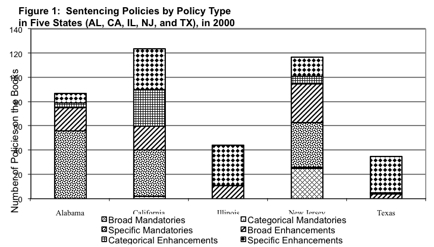
Admission Rates
The dependent variable, rates of admission to prison, is given by the number of people admitted into a state’s prisons in a given year per 100,000 residents. I constructed this variable using prison admission counts from the National Corrections Reporting Program’s (NCRP) Prison Admission Data and population counts from the US Bureau of the Census. The NCRP is conducted by the BJS, spans from 1983 to 2001, and provides a comprehensive description of convicted persons' entrance into and departure from correctional custody and correctional supervision. The NCRP prison admissions data are a complete census of every offender admitted to a state prison in a reporting state and contain information on topics such as the race, sex, and age of inmates, and type of offense committed. I exclude offenders admitted for violations of parole or other forms of post-release supervision since these admissions are not affected by the policy changes I examine.
Black and White men’s admission rates both increased dramatically from 1983 to 2001. However, while Black men’s admission rates increased by 59%, White men’s admission rates increased by only 33%. Also significant, since White men’s admission rates was less than one-fourth of Black men’s in 1983 even a similar increase in terms of percent would be smaller in real numbers. As Figure 2 shows, most of the increase in admission rates that occurred during the period studied came through an increase in admissions for drug offenders. However, in the 1990s, there was also a notable increase in admissions for violent offenders. Finally, the growth in racial disparity occurred almost exclusively through a growth in disparity in admissions for drug offenses; in fact, racial disparity in admissions for property and violent offenses remained relatively constant throughout the period.
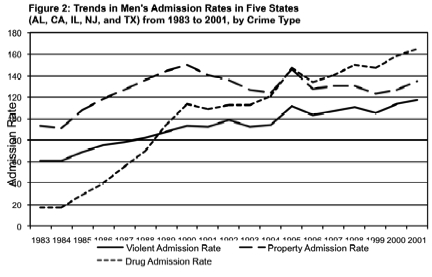
Women’s admission rates present a slightly different story. Black and White women’s admission rates increased at similar rates during the period examined; Black women’s incarceration rates increased by 79% while White women’s incarceration rates increased by 72%. Of course, since White women’s starting admission rates were less than one-fifth of Black women’s admission rates, the absolute increase in White women’s admission rates is smaller. As Figure 3 shows, admissions for drug offenses again increased most dramatically, but increases in admissions for property offenses were also substantial. Finally, racial disparity in women’s admission rates also increased during the period examined and, once again, this increase was achieved almost completely through an increase in disparity among admission for drug offenses. In fact, among women, there was little racial disparity in admissions for drug crimes at the beginning of the time series in 1983.
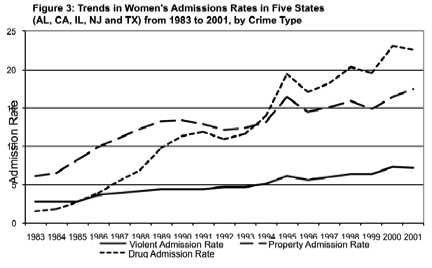
Sentencing Policies
That research on the effects of sentencing policies focuses on states with sentencing guidelines is not surprising; data on the sentencing structures of these states is readily available. However, as discussed earlier, there are compelling theoretical and empirical reasons to examine non-guidelines states. Since there is no comprehensive publicly available data on sentencing structures for non-guideline states, I collected data on sentencing policies using states’ current and past criminal codes.
First, I developed a coding scheme that distinguished different degrees of determinacy and punitiveness in criminal sentencing. In order to do this, I read the complete criminal codes of all five states and created working definitions of sentencing policies, such as ‘mandatory term’ and ‘sentencing enhancement’. I modified these definitions as I progressed through the five states to ensure consistency across states. For instance, it eventually became clear that my original definition of mandatory term as any statute that prescribed a minimum penalty that included imprisonment was unworkable since more than three-quarters of all criminal statutes have this quality in several states. In response, I changed my definition: a mandatory term stipulates a minimum sentence that includes imprisonment and mandates that this sentence cannot be suspended and probation cannot be granted. After a similar process, I arrived at the previously given definition of sentencing enhancements and, in order to maintain the richness of the sentencing policy data, I divided these policies into broad, categorical, and specific enhancements.
Sentencing enhancements mandate that offenders who commit crimes while engaging in other non-criminal behaviors, like being in public housing, or possessing other non-criminal traits, like prior records, receive longer (and surer) sentences than offenders who commit the same crimes without engaging in these non-criminal behaviors and without these traits. Broad enhancements apply to all offenders regardless of their offense; enhancements for habitual offenders and crimes motivated by bias are common examples. Categorical enhancements apply to all crimes of a given type. For example, Alabama’s firearm enhancement applies to all offenders convicted of drug crimes. Specific enhancements only apply to a given statute. Using Alabama again as our example, the crime classification of ‘negligent homicide’ is increased if it results from a DUI car accident. This ‘DUI enhancement’ applies only to negligent homicide; thus, it is a specific enhancement.
Mandatory terms stipulate a minimum sentence that includes imprisonment and mandate that this sentence cannot be suspended and probation cannot be granted. Like sentencing enhancements, these can also be broad, categorical, or specific. Broad mandatory terms apply to all offenders regardless of their offense; for example, in New Jersey if any crime is committed for pay the offender must serve between one-half and one-third of their sentence before becoming eligible for parole. Like categorical enhancements, categorical mandatory terms apply to all crimes of a given type. New Jersey has only one categorical mandatory term; a mandatory term applies to all offenders who are convicted of a violent offense that they committed while on parole. Specific mandatory terms only apply to a given statute. Using New Jersey again as our example, any offender convicted of carjacking must serve five years before becoming eligible for parole.
Next, I re-read all five codes making note of each statute that fit into any of these categories. I recorded the statute number, the crime the statute applied to, if the law was an enhancement – the aggravating behavior that resulted in the enhancement, the length of the enhancement or mandatory term, the year the statute was enacted, and every year the statute was changed.
Finally, because it is impossible to know if the statute became a mandatory term or a sentencing enhancement in the year it was enacted or in one of the years in which it was changed8 , I traveled to the state law libraries of each state and traced the history of every policy. Doing this, I realized that most statutes (nearly 80%) did not take on the form of interest when they were adopted but, instead, only became mandatory terms or sentencing enhancements when they were modified. Thus, any research that uses the year a statute was adopted in order to estimate the year a mandatory or enhancement was enacted is incorrect most of the time.
While there were very few sentencing enhancements of mandatory terms on the books in these five states in 1977, states adopted dozens of these policies during the period studied – as Figure 4 shows. By 2001, the five states in this study had adopted an average of 20 enhancements or mandatory terms that apply to all offenses, 51 enhancements or mandatory terms that apply to violent offenses, 9 enhancements or mandatory terms that apply to property offenses, and 25 enhancements or mandatory terms that apply to drug offenses. While most policies targeting drug crimes were enacted between 1986 and 1990, most policies targeting violent offenses were enacted in the 1990s. Increases in the number of sentencing enhancements and mandatory terms continue into the present.
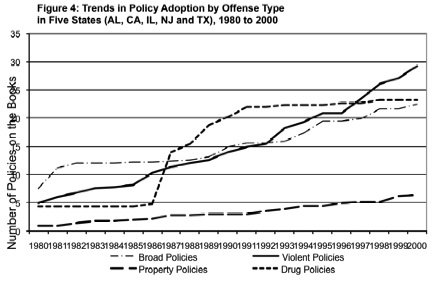
Additional Explanatory Variables
In addition to measures of sentencing, all analyses include controls for variables other theories suggest increase prison admission rates. Many criminologists argue that mass incarceration serves to restore order in response to the posited chaos (and resultant high crime rates) of late modernity (Garland 2001; Jacobs and Helms 1996). In addition, the 1980s and 1990s saw the introduction of aggressive police tactics (Jackson 1989; Neugebauer 1996). Arrest rates, which control for shifts in both policing and offending, are constructed using data from the Uniform Crime Reports and the US Bureau of the Census. Scholars also argue that public opinion shapes punishment outcomes (Beckett 1997; Garland 2001). I measure punitive opinion with General Social Survey, recording whether respondents think the criminal justice system is too lenient or too harsh on a Likert scale. Finally, stratification theorists argue that elites use imprisonment in order to “control the dangerous classes”. As such, increases in the proportion of a state’s residents who are racial or ethnic minorities (Arvanites and Asher 1995; Blumer 1958; Blalock 1967; Bobo and Hutchings 1996) or economically marginal (Chambliss and Seidman 1982; Chiricos and Delone 1992; Rusche and Kirchheimer 1968) will lead to increases in the state’s punitiveness. In addition, the Bureau of Justice Statistics finds that the majority of crime is committed by people in late adolescence and that trend is consistent throughout the last quarter of the twentieth century (BJS 2007). State level demographic variables include labor force participation, percent Black, and the percent of the population aged 15 to 19. I take these variables from the Current Population Survey9 .
Estimation
I employ pooled cross-sectional time-series analysis with state-level fixed effects to examine the effects of all determinate sentencing policies enacted within each state on the state-level prison admission rates of Black and White men and women. I fit the models to the following twelve dependent variables: admission rates by race (Black and White), sex (Male and Female), and crime type (Violent, Property, and Drug). The explanatory variables in the model include a determinate sentencing variable, controls for violent and property arrest rates, public opinion on the ‘harshness’ of the criminal justice system, and state level demographics – labor force participation, percent Black, and percent aged 15 to 19.
Because of the panel structure of the data, I fit fixed effects to control for all state-level omitted variables that may be correlated with the adoption of determinate sentencing policies and may affect admission rates. A variety of time-invariant, state-level characteristics may affect the adoption of sentencing policies. Although, fixed effects models cannot be used to discover what state level characteristics affect sentencing policy adoption, they do adequately control for these variables by using only within-state variation to estimate the effects of mandatory minimum terms and sentencing enhancements on prison admission rates10.
Finally, the determinate sentencing variables count the number of each policy type on the books in each state-year and are lagged by one year, the average amount of time it takes for a case to move from arrest to sentencing in the State Court Processing Data. By allowing time for adjudication, this ensures that the models consider the effects of sentencing laws that were on the books at the time of an offender’s arrest, since these are the laws that are used in case processing11 .
After estimating each model separately, I use simultaneous estimation followed by a Wald Test to examine whether the differences in the sentencing coefficients from the models run on Black admission rates and White admission rates are significant12.
Analyses
I find that both mandatory terms and sentencing enhancements are associated with increases in state-level violent, property, and drug admissions regardless of sex or race. However, they disproportionately increase women’s admission rates for all three offense types.
Violent Admissions
As Table 1 shows, while mandatory terms and sentencing enhancements are associated with increases in violent admission rates regardless of sex or race, these policies disproportionately impact women.
Each broad mandatory term that a state adopts is associated with increases in violent admission rates of four percent for Black men, ten percent for Black women, three percent for White men, and eight percent for White women. Although New Jersey is the only state that has adopted more than one broad mandatory term, even the single policies enacted in Alabama, California, and Illinois are associated with noticeable effects.
Categorical mandatory terms that target violent offenses have no effect on admission rates, regardless of race or sex. In contrast, specific mandatory terms, those that apply only to a particular violent offense, increase Black men and women’s and White women’s admission rates by two percent, five percent, and four percent respectively; these policies have no effect on White men’s violent admission rates. This means that in Alabama, where seven specific mandatory terms that target violent offenses were enacted between 1983 and 2001, these policies are associated with cumulative increases in Black men’s incarceration rates of fourteen percent, in White women’s incarceration rates of twenty-eight percent, and in Black women’s incarceration rates of thirty-five percent
Sentencing enhancements also increase admission rates for violent offenses, for Black and White men and women. The adoption of each broad sentencing enhancement has no effect on Black men’s violent admission rates, but increases Black women’s violent admission rates by three percent, White men’s by two percent, and White women’s by three percent. In California, twenty broad sentencing enhancements were enacted between 1982 and 2000; taken together, these policies are associated with increases of sixty percent in Black and White women’s violent admission rates of forty percent in White men’s violent admission rate.
The adoption of each sentencing enhancement that applies whenever an offender is convicted of a violent offense (a categorical enhancement) is associated with an increase in violent admission rates of three percent for Black men, seven percent for Black women, eight percent for White men, and nine percent for White women. Only California and New Jersey have policies of this type and in New Jersey, there is only one such policy. As a result, the effects of these policies are primarily restricted to California.
Finally, each specific sentencing enhancement (that applies to a violent offense) enacted increases Black women’s and White men and women’s violent admission rates but has no effect on Black men’s violent admission rates. More particularly, each policy of this type enacted is associated with a five percent increase in Black women’s violent admission rates, and a six percent increase in both White men and women’s violent admission rates. Illinois adopted fifteen of these policies by 2000. The cumulative effect of these policies in Illinois, then, is to increase Black women’s violent admission rates by sixty-five percent, increase both White men and women’s violent admission rate by ninety percent.
Finally, I use simultaneous regression followed by a Wald Test to evaluate whether the mandatory terms and sentencing enhancements examined do, in fact, disproportionately burden women. Results from these tests show that the disparate impact of both broad and specific mandatory terms and broad, categorical, and specific sentencing enhancements on violent admission rates is significant, among Blacks. However, among whites, only broad mandatory terms disproportionately burden women. This implies that these policies are especially burdensome for Black women.
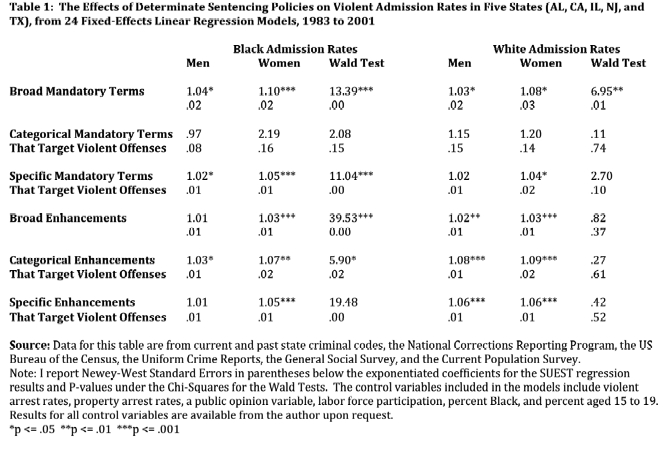
Property Admissions
The analyses of the effects of determinate sentencing policies on admissions to prison for property offenses mirror the analyses for violent admissions. As Table 2 shows, mandatory terms and sentencing enhancements are associated with increases in admission rates that disproportionately burden women and once again, this disparity is most pronounced among Blacks. However, the effects of sentencing enhancement policies on admissions for property crimes are less consistent than the effects of these policies on violent admissions. Since many of the sentencing enhancements that states enacted in the 1990s targeted violent offenses and few mandatory terms or sentencing enhancements target property crimes, this is not surprising.
The adoption of each broad mandatory term is associated with an eleven percent increase in Black men’s, a thirteen percent increase in Black women’s, a nine percent increase in White men’s, and a twelve percent increase in White women’s admission rates for property crimes. Although New Jersey is the only state that has adopted more than one broad mandatory term, the single policies enacted in Alabama, California, and Illinois are associated with thirteen percent increases in Black women’s property admission rates – not a negligible effect.
There are no categorical mandatory terms that target property offenses. The adoption of each specific mandatory term (that applies to a property offense) is associated with a sixteen percent increase in Black men’s property admission rates, a twenty-five percent increase in Black women’s property admission rates, a thirty-one percent increase in White men’s property admission rates, and a twenty-nine percent in White women’s property admission rates. In New Jersey, where three mandatory terms targeting property were enacted between 1983 and 2001, these policies are associated with cumulative increases of forty-two percent for Black men, one-hundred percent – or a doubling – for Black women, one-hundred and twenty four percent for White men, and one-hundred and sixteen percent for White women.
Examining the effects of sentencing enhancements on prison admissions for property crimes, I find that the adoption of each broad sentencing enhancement is associated with a two percent increase in Black men’s, three percent increase in Black women’s and White men’s, and a four percent increase in White women’s property admission rates. In Texas, where four policies of this type were enacted between 1983 and 2001, the cumulative effects of these policies is to increase Black men’s property admission rates by eight percent, Black women’s and White men’s by twelve percent, and White women’s by sixteen percent.
The adoption of sentencing enhancements that apply whenever an offender has been convicted of a property offense (a categorical sentencing enhancement) has no effect on admission rates, for Black or men or women or White women. However, these polices are associated with a thirty-seven percent increase in White men’s admission rates for property crimes.
The adoption of each specific sentencing enhancement only affects White women; here the policies are associated with a nine percent increase. Looking at Texas again, where seven specific sentencing enhancement targeting property crimes were enacted during the period examined, these policies are associated with cumulative increases of sixty-three percent increase for White women.
Turning our attention to the Wald tests performed after simultaneous estimation of the models, I find that mandatory terms and sentencing enhancements disproportionately burden women among both Blacks and Whites. More particularly, I find that the specific mandatory terms that target property crimes and broad sentencing enhancements disproportionately burden women among Blacks but not Whites. Categorical mandatory terms, as noted above, actually disproportionately burden White men13 . This is the only case in this study where a policy disproportionately affects men (and the affect is confined to White men). In all other cases where there is a disproportionate affect, the policies disproportionately burden women. Specific sentencing enhancements that target property crimes disproportionately burden women among both Black and Whites. Broad mandatory terms are the only policy where I find no evidence of a disproportionate affect.
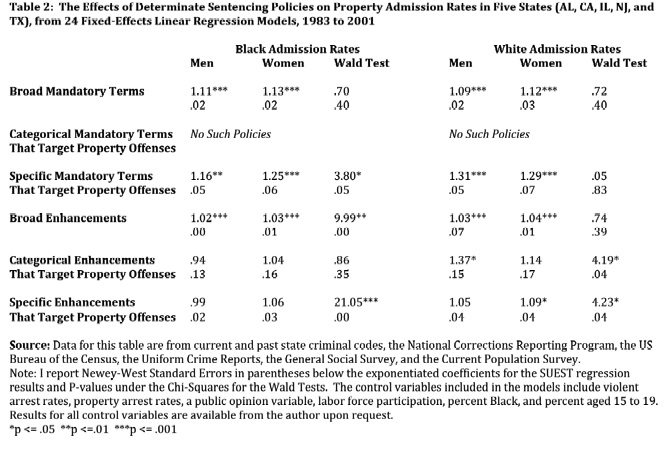
Drug Admissions
Looking at Table 3, you can see that mandatory terms and sentencing enhancements not only increase drug admission rates among men and women, regardless of race; they also disproportionately increase women’s admissions, among both Blacks and Whites. More particularly, the adoption of each broad mandatory term is associated with a seventeen percent increase for Black men, a twenty-two percent increase for Black women, and twenty percent increase for White men, and a twenty-nine percent increase for White women. Once again, while New Jersey adopted 25 broad mandatory terms between 1982 and 2000, no other state adopted more than one. Thus, the effects of these policies will primarily be limited to New Jersey.
There are no categorical mandatory terms that target drug offenses. Specific mandatory terms that apply only to individual drug offenses have no affect on prison admissions for drug crimes, among Black or White men or women. However, the adoption of each broad sentencing enhancement is associated with increases in drug admission rates of five percent for Black men, nine percent for Black women, eight percent for White men, and ten percent for White women. This means that in Illinois, where 10 policies of this type were enacted between 1982 and 2000, these policies are associated with increases in drug admission rates of fifty percent for Black men, ninety percent for Black women, eighty percent for White men, and one-hundred percent for white women.Similarly, the adoption of a categorical sentencing enhancement that targets drug offenses is associated with increases in drug admission rates of twelve percent for Black women, sixteen percent for White men, and eighteen percent for White women. These policies have no effect on Black men’s admission rates. Alabama enacted four policies of this type between 1983 and 2001; cumulatively, these policies are associated with increases in drug admission rates of forty-eight percent for Black women, fifty-two percent for White men, and seventy-two percent for White women.
The adoption of each specific sentencing enhancement that applies to a drug offense is associated with increases in drug admission rates of seven percent for Black men and White women and of twelve percent for Black women. These policies have no effect on White men’s drug admission rates. California adopted eight policies of this type during the period studied; cumulatively, they are associated with a fifty-six percent increase for Black men and White women and a ninety-six percent increase for Black women.Looking once again at the Wald tests performed after simultaneous estimation of the models, all of the policies except specific mandatory terms disproportionately burden women, and the results are slightly more consistent among Blacks. Broad mandatory terms, broad sentencing enhancements, and specific sentencing enhancements disproportionately burden Black and White women. Categorical sentencing enhancements disproportionately burden Black women, but have no disproportionate affect among Whites. Only for specific mandatory terms is there no evidence of a disproportionate affect.
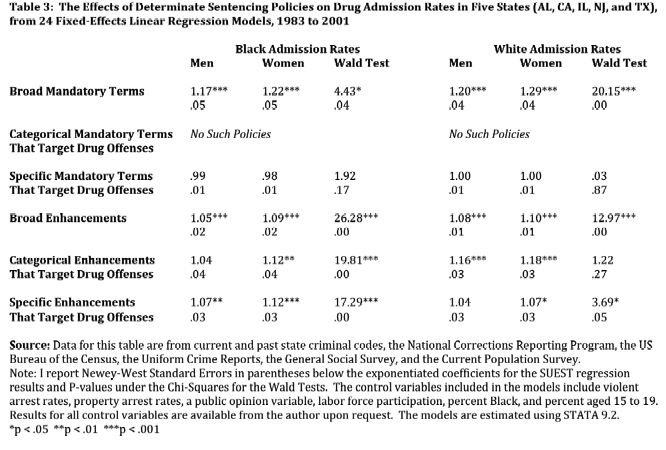
Discussion
This study has four major findings. First, mandatory terms and sentencing enhancements increase prison admission rates for violent, property, and drug crimes among Black and White men and women. Second, these policies disproportionately burden women, regardless of offense type. Third, the gender disparate impacts of these policies are most consistent among Blacks, suggesting that these policies are not only gendered in their affects, but also racialized. Finally, the affects of these policies are most consistently associated with increases in violent admissions, but associated with the most substantial increases in drug admissions. These findings corroborate earlier work (Bloom, Owen, & Covington 2004; Chesney-Lind 1978; Covington & Bloom 2003; Datesman & Scarpitti 1980; Raeder 1993; Steffensmeier 1980) arguing that these policies are, in part, responsible for the disproportionate increases in incarceration women experienced in the last quarter century of the twentieth century.
The findings of this study suggest that mandatory terms and sentencing enhancements played a role in the dramatic and disproportionate increase in women’s incarceration rates that began in the late 1970s and continues today. In 1980, 4% of people in prison were women; by 2000, over 7% of prisoners were women (BJS 1981, 2001; US Census Bureau 1980, 2000). Several scholars have argued (Bloom, Owen, & Covington 2004; Chesney-Lind 1978; Raeder 1993; Steffensmeier 1980) that changes in sentencing policies played an active part in increasing the proportion of the correctional population that is women. While some scholars argue that determinate sentencing policies undermined ‘paternalism’ (Chesney-Lind 1978; Datesman & Scarpitti 1980; Steffensmeier 1980), others argue that these policies made it difficult for judges and other criminal justice officials to consider socially relevant (and highly gendered) characteristics, such as childcare responsibilities (Bloom, Owen, & Covington 2004; Covington & Bloom 2003) and level of culpability (Gaskins 2004), and yet others argue that these policies increased the weight given to (the gendered behavior of) prosecutorial assistance (Raeder 1993). The findings of this study suggest that changes in sentencing policies are, in part, responsible for the dramatic increases in incarceration women have been experiencing for the past quarter century and thus lend preliminary support to the above arguments. Future studies should examine the mechanisms through which mandatory terms and sentencing enhancements disproportionately burden women; for instance, a study could attempt to separate the affects of decreased sentencing benefits for being a primary care giver from the affects of increased sentencing benefits for prosecutorial assistance.
Moreover, while it is not surprising that mandatory terms and sentencing enhancements both increase prison admissions, these findings contradict the ‘continuing discretion thesis’ that argues that judges and other court officials circumvent sentencing policy to such a large extent that determinate sentencing policies have little or no effect on punishment outcomes while confirming ‘conventional wisdom’ that these policies are implicated in the prison boom. With the enactment of mandatory terms, judges lose the option of granting offenders convicted of certain crimes non-custodial sentences. With the enactment of sentencing enhancements, sentences increase in severity – sometimes from non-custodial to custodial and sometimes from a short sentence of incarceration to a longer sentence of incarceration. In both cases, prison admission rates may increase. In the first case, sentencing enhancements increase prison admission rates by incarcerating offenders who would have received probation, suspended sentences, or other non-custodial sentences. In the second case, sentencing enhancements increase prison admission rates by increasing offenders’ sentence from a jail sentence to a prison sentence. While it is undoubtedly true that judges, prosecutors, and other criminal justice officials often circumvent new sentencing policies through plea bargains, reduced charges, and downward departures, this study suggests that shifts in policy never-the-less affect punishment outcomes. While it may be possible to circumvent a particular statute indefinitely or comprehensive shifts in sentencing policy temporarily, it seems criminal justice officials are not able to circumvent comprehensive shifts in sentencing policies indefinitely.
Finally, while the affects of a single policy on property admissions are approximately as large as those on drug admissions, there are considerably fewer of these policies, thus minimizing their affect in that domain. None-the-less, it should be noted that mandatory terms and sentencing enhancements both increased admission rates for violent, property and drug crimes for Black and White men and women. As such, the power of these policies is quite sweeping.
New sentencing policies, including mandatory terms and sentencing enhancements, can be seen as producing equality in that they decrease differences in criminal processing that are based on sex per se. However, women are not similarly situated to male defendants: they are more likely to lose their children do to imprisonment, they are on average less culpable offenders and, relatedly, they are less likely to be able to provide substantial prosecutorial assistance. As a result, these policies can have disparate impacts by increasing or decreasing weight to legal characteristics, like level of culpability or prosecutorial assistance, that are clearly gendered. If we think of gender as containing a bundle of traits that correlate closely but not perfectly with sex (Siegel 2001), it becomes clear that policies can produce inequality by ‘blindly’ judging based on a presumably gender neutral but in fact thoroughly gendered characteristic, such as level of culpability. Laws that do this will not be able to promote gendered justice. In fact, these policies not only fail to undermine the systems of privilege that leave women and men who are criminal defendants dissimarly situated, but actually disproportionately burden women by ignoring gender inequalities.
The findings of this study call for new sentencing policies that are ‘gender conscious’. Such policies would reflect and respond to gendered differences in criminal offenders and would value justice over a meaningless, statistical, ‘equality’. As precedent to the type of change I am recommending, we could look to the Andrews v Law Society of British Columbia (1989). I this case, the similarly situated requirement was challenged and rejected in Canada; the court found the requirement “seriously deficient” for producing equality and instead adopted an approach based on substantive historical disadvantage (MacKinnon 1991). Adopting such an approach in the US could help us to avoid adopting more policies that reify rather than rectify gendered and racialized inequalities.
1 Imprisonment rates are the number of people in state and federal prisons on a given day per 100,000 people in the population. Admission rates are the number of people admitted to state or federal prisons each year per 100,000 people in the population.
2 See Alschuler (1978) for a discussion of how ‘determinate sentencing policies’ increase prosecutorial power.
3 Reed v. Reed, 404 U.S. 71 (1971), was an Equal Protection case in the United States in which the Supreme Court ruled that the administrators of estates cannot be named in a way that discriminates between sexes.
4 Related studies examine gender disparities under state and federal guidelines. Most find that women still receive more lenient treatment then men under guidelines due to women receiving departures for child care related concerns (Koons-Wit 2002; Robinson 2000; Williams 1999). However, King (1996) finds that while the US guidelines are neither facially gender based nor applied differently to men and women, they disproportionately impact women because judges considered child care and other gender related variables more before the guidelines were passed than after.
5 I estimate the models using STATA 9.2.
6 Eighteen states and the federal government have adopted sentencing guidelines. These structures establish both minimum and maximum sentences for offenses and precise measures for the influence of mitigating and aggravating factors. However, thirty-two states have not adopted guidelines but have overlaid their traditional criminal codes with individual sentencing policies, such as sentencing enhancements and mandatory terms (Tonry and Hatlestad 1997).
7 While an ideal study would include all 32 non-guideline states, data collection for this project was quite intense as it involved extensive archival research at state law libraries on each code. Since collecting and coding sentencing data took several months for each state, and since former studies have almost exclusively focused on single systems (either the federal system or a single state), I believe this study makes an advance towards generalizeability from previous research.
8 Criminal codes list the year a statute was adopted and every year it was amended. However, they do not state the original text of the statute or list what changes were made on what years.
9 Descriptive statistics for all dependent and independent variables are available from the author upon request.
10 Diagnostics revealed both autocorrelation and heteroskedasticity, I use Newey-West standard errors in order to correct for these problems. Beck and Katz (1995) find that using panel corrected errors, such as the Newey-West standard errors, produces more efficient estimation than FGLS models – the standard alternative for correcting heteroskedasticity and autocorrelation.
11 In state j and year t, Black men’s violent admission rates, Yjt, for example, can be written in the regression,Yjt = Sjt-1β + Vjtβ + Pjtβ + Lpjtβ + Bjtβ + Ajtβ + θi + εjt, where θi is a state level fixed-effect and Sjt-1 is a determinate sentencing variable lagged by one year, Vjt is the arrest rate for violent offenses, Pjt is the punitive opinion variable, Ljt is the labor force participation control, Bjt is the percent Black, Ajt is the percent of a state aged 15 to 19, and εjt is the autocorrelated, heteroscedastic, error term. The model is the same for the other dependent variables except that models estimating property admissions include a control for property arrests instead of violent arrests and those modeling drug admissions include controls for violent and property arrests since the UCR does not contain information on drug arrests.
12 STATA’s SUEST command combines the estimation results from the previous models into a single parameter vector and simultaneous (co)variance matrix of the sandwich/robust type and thus allows researchers to test cross-model hypotheses, even when the models are estimated on different samples.
13 This may because men’s criminality is typically conceived of as involving either violence or drugs, while women’s criminality is conceived of as involving property crimes. As a result, it may be true that prior to the adoption of mandatory terms and sentencing enhancements men who committed property crimes were not seen as a threat and were therefore likely to be sentenced to community based sanctions instead of terms of incarceration.
Notes
REFERENCES
Arvanites, Thomas. & Martin Asher. 1995. The direct and indirect effects of socio-economic variables on state imprisonment rates. Criminal Justice Policy Review 7, 27-53.
Bales, William. & Linda Dees. 1992. Mandatory minimum sentencing in Florida: Past trends and future implications. Crime & Delinquency 38,309-29.
Beck, Nathaniel. & Jonathan Katz. 1995. What to do (and not to do) with time-series cross-section data. American Political Science Review 89, 634-647.
Beckett, Katherine. 1997. Making Crime Pay: Law and Order in Contemporary American Politics. (Oxford University Press).
Blalock, Hubert. 1967. Toward a Theory of Minority Group Relations. (Wiley Publishers).
Bloom, Barbara, Barbara Owen & Stephanie Covington. 2004. Women offenders and the gendered effects of public policy. Review of Policy Research 21, 31-48.
Blumer, Herbert. 1958. Race prejudice as a sense of group position. Pacific Sociological Review 1, 3-7.
Blumstein, Alfred. 1984. Sentencing reforms: Impacts and implications. Judicature 6, 129-39.
Bobo, Lawerence. & Vincent Hutchings. 1996. Perception of racial group competition: Extending Blumer's theory of group position to a multiracial social context. American Sociological Review 16, 951-72.
Brown, Micheal, Martin Carnoy Elliot Currie, & Troy Duster, David B. Oppenheimer, & Marjorie Shultz, & David Wellman. 2003. White-Washing Race: the Myth of a Colorblind Society. (University of California Press).
Chesney-Lind, Meda. 1978. Chivalry re-examined: Women and the criminal justice system. In L. Boker (Ed.) Women, Crime, and the Criminal Justice System. (Lexington Books).
Chiricos, Ted & Miriam Delone. 1992. Labor surplus and punishment: A review and assessment of theory and evidence. Social Problems 39, 421–46.
Covington, Stephanie & Barbara Bloom. 2003. Gendered justice: Women in the criminal justice system. In Bloom, B. (Ed.) Gendered Justice: Addressing Female Offenders. (Carolina Academic Press).
Crawford, Charles. 2000. Gender, race, and habitual offender sentencing in Florida. Criminology 38, 263-80.
Crawford, Charles, Ted Chiricos, Gary Kleck. 1998. Race, racial threat, and sentencing of habitual offenders. Criminology 36, 481-511.
Daly, Kathleen. 1987. Structure and Practice of Familial-Based Justice. Law & Society Review. 21, 267-290.
Daly, Kathy. 1989. Rethinking judicial paternalism: Gender, work-family relations, and sentencing. Gender and Society 3, 9-36.
Daly, Kathleen and Rebecca Bordt. 1995. Sex Effects and Sentencing: an analysis of the statistical literature. Justice Quarterly 12, 141-175.
Datesman, Susan. & Frank Scarpitti. 1980. Women, Crime, and Justice. (Basil).
Drukker, David. 2003. Testing for serial correlation in linear panel-data models. Stata Journal 3, 168-177.
Engen, Rodney & Sara Steen. 2000. The power to punish: Discretion and sentencing reform in the war on drugs. American Journal of Sociology 105, 1357-95.
Farrell, Jill. 2003. Mandatory minimum firearm penalties: A source of sentencing disparity? Justice Research and Policy 5, 95-115.
Fischer, Daryl. & Andy Thaker. 1992. Mandatory Sentencing Study. (Department of Arizona Corrections).
Garland, David. 2001. Culture of Control: Crime and Social Order in Contemporary Society. (University of Chicago Press).
Gaskins, Shimica. 2004. “Women of Circumstance” – The effects of mandatory minimums sentences on women minimally involved in drug crimes. American Criminal Law Review. 41, 1533-15553.
Iowa Statistical Analysis Center. 1985. Mandatory Minimum Sentences: an Analysis of Impact on Prison Population and Recidivism. (Iowa Government Printing Office).
Jacobs, David. & Richard Helms. 1996. Toward a political model of incarceration: A time-series examination of multiple explanations for prison admission rates. American Journal of Sociology 102, 323-57.
Jackson, Pamela 1989. Minority Group Threat, Crime, and Policing. (Praeger).
MacKinnon, Catharine. 1991. Reflections on Sex Equality under Law. The Yale Law Journal. 100, 1281-1328.
Marvell, Thomas & Carlisle Moody. 2001. The lethal effects of three-strikes laws. Journal of Legal Studies 30, 89-106.
Mauer, Marc. 1999. Race to Incarcerate. (The New York Press).
Miller, Harold. & Alfred Blumstein. 1979. The Impact of New Sentencing Laws on State Prison Population in Pennsylvania: Final Report. (The Pittsburgh Institute).
Morelli, Ralph. 1986. The effects of five-year mandatory sentencing in Pennsylvania. Justice Analyst 1, 1-8.
Neugebauer, Randy 1996. Police-Community Relations: The Impact of Culture on the Control of Colour. (University Microfilms International).
Nicholson-Crotty, Sean. 2004. The impact of sentencing guidelines on state-level sanctions: An analysis over time. Crime & Delinquency 50, 395-411.
Petersilia, Joan and Peter Greenwood. 1997. Mandatory Prison Sentences: Their Projected Effects on Crime and Prison Populations. (Rand Corporation).
Raeder, Myrna., 1993. Gender issues in the federal sentencing guidelines and mandatory minimum sentences. Criminal Justice 8, 20-25 & 56 - 63.
Rusche, Georg. & Otto Kirchheimer. 1968.. Punishment and Social Structure. (Russell & Russell).
Schlesinger, Traci. 2005. Racial and ethnic disparities in pretrial criminal processing. Justice Quarterly 22, 170-192.
Siegel, Reva. 2001. Discrimination in the eyes of the law: how ‘colorblindness’ discourse disrupts and rationalizes social stratification. Pp. 99-152 Prejudicial Appearances: the logic of American Anti-Discrimination Law (edited by Robert Post). (Duke University Press).
Spellman, Elizabeth. 1998. Gender and Race: The Ampersand Problem in Feminist Thought, Inessential Woman: Problems of Exclusion in Feminist Thought (Beacon Press).
Spohn, Cassia & Jerry Cederblom. 1991. Race and disparities in sentencing: A test of the liberation hypothesis. Justice Quarterly 8, 305-27.
Spohn, Cassia. & David Holleran. 2000. The imprisonment penalty paid by young, unemployed black and Hispanic male offenders. Criminology 38, 281-306.
Squires, Judith. 1999. Equality. Gender in Political Theory. (Wiley, John & Sons, Inc.).
Sorenson, Joseph and Donald Stemen. 2002. The effect of state sentencing policies on incarceration rates. Crime & Delinquency 48, 456-75.
Steffensmeier, Darrel. 1980. Assessing the impact of the women's movement on sex-based differences in the handling of adult criminal defendants. Crime & Delinquency 26, 344-357.
Steffensmeier, Darrel. & Steven Demuth. 2000. Ethnicity and sentencing outcome in U.S. federal courts: Who is punished more harshly? American Sociological Review 65, 705-29.
———-. 2001. Ethnicity and judges' sentencing decisions: Hispanic-Black-White comparisons. Criminology 39, 145-78
Tonry, Michael. 1996. Malign Neglect: Race, Crime and Punishment in America. (Oxford University Press).
———-. 1998. Sentencing Matters. (Oxford University Press).
Tonry, Michael. & Kathleen Hatlestad. 1997. Sentencing Reform in Overcrowded Times: A Comparative Perspective. (Oxford University Press).
US Bureau of the Census. 1980. Decennial Census. (US Government Printing Office).
———-. 2000. Decennial Census. (US Government Printing Office).
———-. 2001. Population by Race and Hispanic or Latino Origin for the United States: 1990 and 2000. (US Government Printing Office).
US Department of Justice, BJS. 1976. Correctional Populations in the United States, 1975. (US Government Printing Office).
———-. 1981. Correctional Populations in the United States, 1980. (US Government Printing Office).
———-. 1984. Prison and Jail Inmates at MidYear, 1983. (US Government Printing Office).
———-. (1983 – 1999). National Corrections Reporting Program. (US Government Printing Office).
———-. (1997). Lifetime Likelihood Report. (US Government Printing Office).
———-. (2000). Incarcerated Parents and Their Children. (US Government Printing Office).
———-. (2001). Correctional Populations in the United States, 2000. (US Government Printing Office).
———-. (2002). Prison and Jail Inmates at MidYear, 1983. (US Government Printing Office).
———–. (2006a). Prisoners in 2005. (US Government Printing Office).
———-. (2006b). State Court Processing Statistics, 1990 – 2002: Felony Defendants in Large Urban Counties. (US Government Printing Office).
———–. (2007). Corrections Facts at a Glance. (Retrieved June 13, 2007). (http://www.ojp.usdoj.gov/bjs/glance.htm#Corrections).
Vincent, Barbara. & Paul Hofer. 1994. The Consequences of Mandatory Minimum Prison Terms: A Summary of Recent Findings. (Washington, DC).
Wacquant, Loic. Forthcoming 2008. Deadly Symbiosis: Race and the Rise of Neoliberal Penality. (Polity Press).
Wilson, Deborah and Gennaro Vito. 1990. Persistent felony offenders in Kentucky: A comparison of incarcerated felons. Journal of Contemporary Criminal Justice 6, 237-53.




